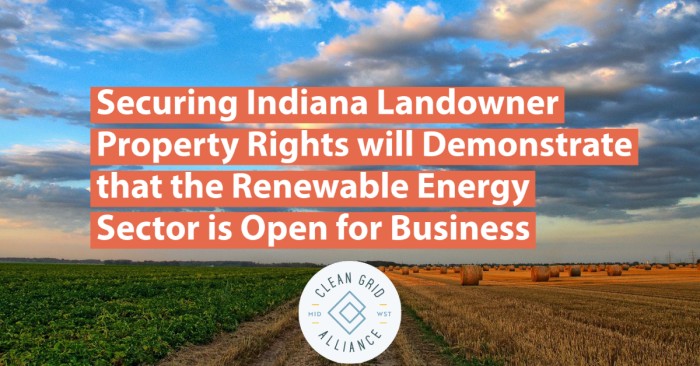Securing Indiana Landowner Property Rights will Demonstrate that the Renewable Energy Sector is Open for Business
 | Holly Fritz, Communications/Policy Associate |

 | Holly Fritz, Communications/Policy Associate |
It’s a fact. The U.S. is transitioning away from fossil fuels and embracing the great benefits of renewable energy. Wind and solar energy are reliably powering homes and businesses across the Midwest at record low prices, and investment and jobs are booming. For the Hoosier state, renewables are contributing $7 billion to the economy.
Indiana is blessed with strong wind and solar energy resources and access to good energy markets. Renewable energy accounted for about seven percent of the state’s electricity in 2019, most of which is attributed to wind. Consumers and businesses want cost-effective, renewable energy and many Indiana utilities are looking to renewables to serve their customers. This presents significant economic opportunities for Indiana’s rural communities to benefit directly from the investment, new jobs and tax revenue created by wind farms and solar parks.
A balanced approach to siting renewable energy projects that protects communities and preserves a local government’s ability to issue permits and approve or deny a project on its merits is just the type of precedent-setting leadership that Indiana needs. Farmers and private landowners most often host renewable energy projects on their property, and those citizens should have the right to decide how best to use their property. Securing property rights ensures that development companies negotiate with counties in good faith to determine if a project is a fit for the county.
Ranking 16th in the country for installed capacity, Indiana has 3,275 megawatts (MW) of operating wind, solar and energy storage on the grid powering an impressive 911,000 homes. State and local taxes contribute $34.1 million to the coffers every year. Additionally, annual land lease payments of $15 million are paid to rural landowners.
Indiana’s solar sector is just getting started, but big things are on the horizon. Although it ranks 20th in the nation, Indiana's installed solar capacity doubled in the last year, with 939 MW currently online. Indiana is projected to add over 4,500 MW over the next five years, the third highest megawatt increase in the country. Solar prices have dropped 90 percent since 2009, making it one of the cheapest sources of electricity. Indiana’s solar industry employs over 3,000 people through its 80 solar companies, including 24 manufacturers, 30 installers and developers and 26 other related companies. The solar industry has invested over $1.1 billion in the state, and this will certainly increase as capacity grows.
As the state decarbonizes and Hoosiers reap the benefits of clean energy, Indiana’s power sector is reaching new heights. Ratepayers and job-seekers will continue to benefit from low-cost clean energy as the state welcomes more clean energy projects. New job opportunities will emerge in high and low-populated areas, and businesses will continue to grow. According to Clean Jobs Midwest, Indiana had nearly 87,000 clean energy jobs prior to COVID-19. These jobs are located across the state, with more than 18 percent located in rural areas at the end of 2019. Renewable energy was the third largest clean energy employer in Indiana in 2019, with 10,975 workers.
As America’s energy sector transitions to a clean energy economy, states are implementing new strategies so that everyone can access these resources. States are also setting carbon-reduction goals. Indiana is uniquely located to provide renewable energy into the PJM and MISO energy markets to help meet the renewable energy goals of neighboring states. However, the state’s current patchwork of renewable energy ordinances has allowed opponents, often peddling misinformation, to hijack renewable energy project permitting and development.
CGA has been actively engaged in legislation to ensure a stable, predictable permitting process that will spur billions of dollars in renewable energy investment while protecting local Hoosier communities and the property rights of landowners. These efforts will increase clean energy output, power more homes at a low price and create more economic opportunity – and that’s just smart!